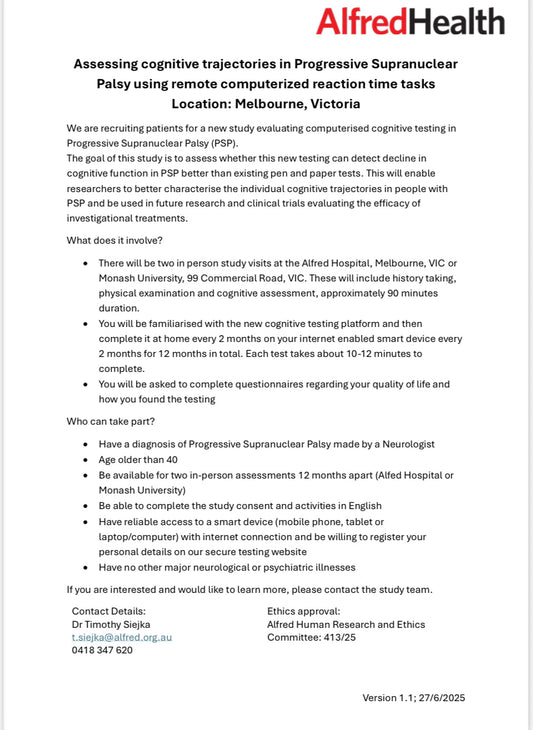Multiple System Atrophy (MSA) is a rare and progressive neurodegenerative disorder that affects multiple systems in the body, including movement, balance, and autonomic functions like blood pressure regulation. Often initially misdiagnosed as Parkinson’s disease, MSA has unique features and a faster progression. This article provides an overview of MSA, its symptoms, and practical tips for managing the condition.
Quick Facts About MSA
- MSA is a type of synucleinopathy, caused by the buildup of alpha-synuclein protein in the brain’s glial cells [1].
- It affects approximately 2 to 5 out of every 100,000 people, making it rarer than Parkinson’s disease [2].
- The average age of onset is around 50 to 60 years, and it is extremely rare before age 30 [3].
- MSA has two main subtypes: MSA-P (parkinsonian type) with more movement symptoms, and MSA-C (cerebellar type) with more coordination issues [4].
- Life expectancy after diagnosis is typically 6 to 10 years, though this varies depending on the individual [5].
Common Symptoms of MSA
MSA symptoms differ based on subtype but generally impact multiple bodily systems. Here are the most common signs:
- Parkinsonian Symptoms: Tremors, stiffness, and slow movements (bradykinesia), especially in MSA-P, though these may respond poorly to Parkinson’s medications [6].
- Balance and Coordination Problems: Unsteady gait, frequent falls, or clumsiness, particularly in MSA-C due to cerebellar dysfunction [7].
- Autonomic Failure: Low blood pressure when standing (orthostatic hypotension), dizziness, bladder control issues, and constipation [8].
- Speech and Swallowing Difficulties: Soft, slurred speech or a high-pitched voice, along with trouble swallowing (dysphagia) [9].
- Sleep and Breathing Issues: Sleep apnea, loud snoring, or irregular breathing patterns, such as stridor, especially at night [10].
Tips for Managing MSA
There is no cure for MSA, but targeted strategies can help manage symptoms and improve daily life for patients and caregivers:
- Consult Specialists: See a neurologist with MSA expertise for diagnosis and care. Physical therapists can assist with mobility, while urologists or cardiologists may address autonomic issues.
- Prevent Falls: Use assistive devices like canes or walkers, clear home hazards, and monitor blood pressure to avoid fainting from orthostatic hypotension.
- Manage Autonomic Symptoms: Wear compression stockings, increase salt intake (if doctor-approved), and elevate the head of the bed to reduce dizziness and improve sleep.
- Speech and Swallowing Support: Work with a speech therapist for communication aids or swallowing techniques. Soft or pureed foods may ease eating difficulties.
- Monitor Breathing: Use a CPAP machine for sleep apnea if prescribed, and report breathing changes to a doctor promptly, as they can worsen over time.
Multiple System Atrophy is a complex and rare condition that requires a multifaceted approach to care. Its mix of movement, autonomic, and coordination symptoms sets it apart from other disorders. Early diagnosis and tailored management can help alleviate some challenges. If MSA is suspected, seek expert medical guidance to create a personalized plan.
Sources
- National Institute of Neurological Disorders and Stroke (NINDS) - MSA Fact Sheet
- Multiple System Atrophy Coalition - MSA Prevalence
- Mayo Clinic - Multiple System Atrophy Overview
- American Academy of Neurology - MSA Subtypes
- National Organization for Rare Disorders (NORD) - Multiple System Atrophy
- Parkinson’s Foundation - MSA vs. Parkinson’s Disease
- National Organization for Rare Disorders (NORD) - MSA
- Cleveland Clinic - MSA Autonomic Symptoms
- Johns Hopkins Medicine - MSA Clinical Features
- Movement Disorders Society - MSA Sleep and Breathing Issues
Disclaimer
The information provided in this article is intended for educational and informational purposes only. It is not a substitute for professional medical advice, diagnosis, or treatment. The facts, symptoms, and tips presented are based on general knowledge and reputable sources available as of the posting date. They may not reflect the latest research or individual variations in disease presentation and progression.
Every person’s experience with these conditions is unique. Symptoms, outcomes, and management strategies may differ. Always consult a qualified healthcare professional, such as a neurologist or specialist, for personalized guidance tailored to your specific situation. The sources cited aim to ensure transparency and credibility; however, websites and their content may change over time, and accessibility is not guaranteed.
The author and publisher of this article are not liable for any errors, omissions, or consequences arising from the use of this information. Reliance on this content is at your own risk. If you suspect you or a loved one may have one of these conditions, seek prompt medical evaluation from a licensed provider.


 Donate
Donate



